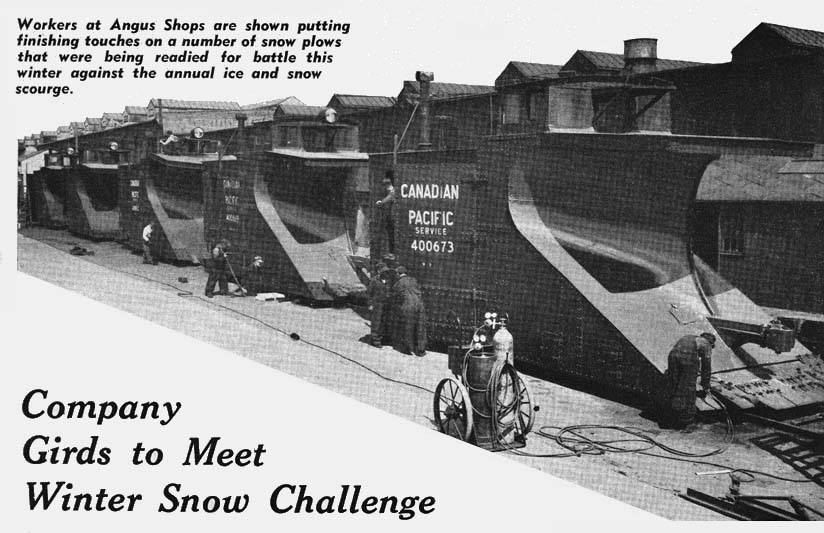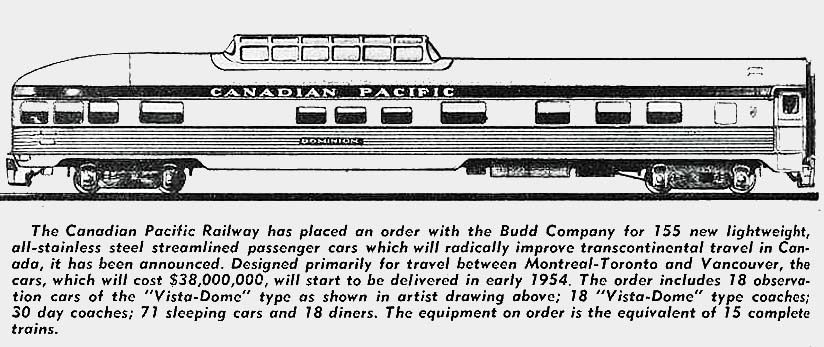

Once again the Company girded itself early to do battle against a major natural enemy, Old Man Winter,
an enemy which costs the railroad millions of dollars each year.
Since early winter trained crews were busy dismantling, repairing, checking, and re-checking available snow removal equipment, getting it in ship-shape condition for the winter.
A careful inventory and inspection was carefully made of all snow removal equipment, and plans were being laid for the annual "snow meeting" at which representatives from the engineering, track, mechanical, signal and transportation divisions meet to exchange their ideas and experiences, and formulate a general plan of operation.
At these meetings the equipment situation is studied and decisions as to the placement of snow removal equipment along the thousands of miles of track are made.
In 1953, snow plows worked a total of 127,193 miles, and the snow removal bill on tracks alone that winter amounted to more than $2,000,000. In some places the units battled snowdrifts as high as 25 feet. On many parts of the line 20 to 35 feet of snowfall annually is not at all uncommon.
In the mountainous sections of Canada, the situation sometimes becomes critical when giant snow slides bury tracks under tons of ice and snow. To battle this perennial enemy, and to keep freight and passenger trains on schedule, the C.P.R. relies on its equipment and the men who work it.
The Company's snow battling units include two giant snow loader and melting tank units, four rotary, and 198 wedge type snow plows, 54 flangers for clearing rails, and 114 spreaders for pushing snow off tracks in freight yards and widening cuts on the main line.
Bulldozers, rotary brooms, and highway plows, and pneumatic ice-chipping tools are main weapons in the front line defence against the inroads of winter's menace. Always ready to change old methods and machinery for more modern, less costly, and more efficient means of combatting the annual snow scourge, the C.P.R. in recent years has built and purchased new machinery, and introduced and improved methods that have been used with marked effectiveness.
Particularly useful in terminal areas are the large snow loader and melting units, which operate equally effectively in dry or wet snow. Another very useful piece of machinery is the old Army "do-all", the bulldozer.
In summer, bulldozers are used in a variety of jobs, including ditching, plowing fire lanes, diverting streams, straightening creeks, building embankments and breaking and levelling ground. In winter time the dozers are placed in service mainly to keep station areas clear of ice and snow.
Small tractors, with plow attachments, are very effective on station platforms and walks. Wing plows are located at strategic points at each division, and rotary plows are confined to mountain areas. Other types of equipment are stationed where they will be of most use.
Emergencies don't occur very often, but when they do, the railroad is ready for them. Men of experience, skill, and ability are on call 24 hours a day. In each division, the names, addresses, and telephone numbers of employees in charge of snow fighting crews are compiled and ready for immediate reference should an emergency arise.

 and is reprinted here with their permission. All photographs,
logos, and trademarks are the property of the Canadian Pacific Railway Company.
and is reprinted here with their permission. All photographs,
logos, and trademarks are the property of the Canadian Pacific Railway Company.
